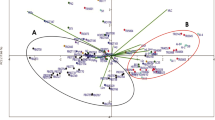Abstract
The concentrations of catechins in a Kenyan tea germplasm collection of 102 accessions were determined by HPLC. Total green leaf catechin concentrations and the ratio of dihydroxylated to trihydroxylated catechins were used to establish genetic differentiation in the germplasm. Upon multivariate analysis, accumulation of the various catechins separated the tea clones into 3 major and 5 minor groups according to their phylogenetic origins. The Cambod teas had the highest ratio (7:10) followed by China teas (3:5) while Assam teas had the lowest ratio (1:4). This biochemical differentiation indicates that there is potential for broadening the genetic base of the mainly Assam teas in Kenya (90%) with the putative China and Cambod teas.
Similar content being viewed by others
References
Banerjee, B., 1992. Botanical classification of tea. In: Willson, K.C. & M.N. Clifford (Eds) Tea Cultivation to Consumption, p. 39. Chapman and Hall, London.
Brown, A.G., C.P. Falsaw, E. Halsam, A. Holmes, & W.D. Ollis, 1966. The constitution of theaflavins. Tetrahedron Lett. 11: 1193–1204.
Harbone, J.B., 1967. Plant phenolics. In: Comparative Biochemistry of Flavonoids, pp. 226–227. Academic Press, London.
Obanda, M. & P. Owuor, 1997. Flavanols composition and caffeine content of green leaf as quality potential indicators of Kenyan black teas. J. Sci. Food Agric. 74: 209–215.
Owuor, P.O. & I.J. McDowell, 1994. Changes in the theaflavin composition and astringency during black tea fermentation. Food Chem. 51: 251–254.
Genstat 5 committee, 1989. Principal component analysis and hierarchical ascendance classification. In: Genstat Reference Manual, pp. 471–508. Clarendon Press, Oxford.
Gerats, A.M. & C. Martin, 1992. Flavanoid Synthesis in Petunia hybrida; Genetics and Molecular Biology of flower colour. In: H.A. Stafford & R.K. Ibrahim (Eds) Phenolic Metabolism in Plants, pp. 167–175. Plenum Press, New York, NY.
Paul, S., F.N. Wachira & R. Waugh, 1997. Diversity and genetic differentiation among populations of Indian and Kenyan tea (Camellia sinensis (L.) O. Kuntze) revealed by AFLP markers. Theor. Appl. Genet. 94: 255–263.
Robertson, A., 1992. The Chemistry and Biochemistry of Black Tea Production, the Non-Volatiles. In: K.C. Willson & M.N. Clifford (Eds) pp. 603–647. Chapman and Hall, London.
Roberts, E.A.H. & R.F. Smith, 1963. Phenolic substances of manufactured tea spectrophotometric evaluation of tea liquors. J. Sci. Food Agri. 14: 489–700.
Takeda, Y., 1994. Differences in caffeine and tannin contents between tea cultivars and application to tea breeding. Jap. Agric. Res. Quart. 28: 117–123.
Takino, Y., H. Imagawa, H. Harikawa & A. Tanaka, 1964. Studies of the mechanism of the oxidation of tea catechins part III. Formation of a reddish orange pigment and its spectral relationship to some benzotropolone derivatives. Agric. Biol. Chem. 28: 64–71.
Visser, T., 1969. Tea, Camellia sinensis (L.) O. Kuntze. In: Ferwarda, F.P. & F. Wit (Eds) Outlines of perrenial crop breeding in tropics, pp. 459–493. H. Veenman & Zonen, Wageningen.
Wachira, F.N., R. Waugh, C.A. Hackett & W. Powel, 1995. Detection of genetic diversity in tea (Camellia sinensis) using RAPD markers. Genome 38: 201–210.
Wachira, F.N., W. Powell & R. Waugh, 1997. Assessment of genetic diversity among Camellia sinensis L. (cultivated tea) and its wild relatives based on randomly amplified polymorphic DNA and organelle specific STS. Heredity 78: 603–611.
Wight, W., 1959. Nomenclature and classification of the tea plant. Nature 183: 1726–1728.
Author information
Authors and Affiliations
Rights and permissions
About this article
Cite this article
Magoma, G., Wachira, F., Obanda, M. et al. The use of catechins as biochemical markers in diversity studies of tea (Camellia sinensis). Genetic Resources and Crop Evolution 47, 107–114 (2000). https://doi.org/10.1023/A:1008772902917
Issue Date:
DOI: https://doi.org/10.1023/A:1008772902917




